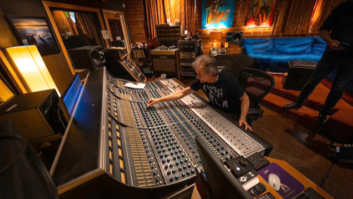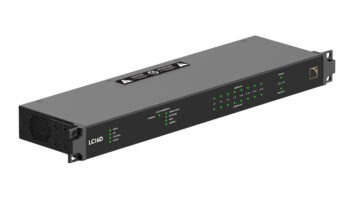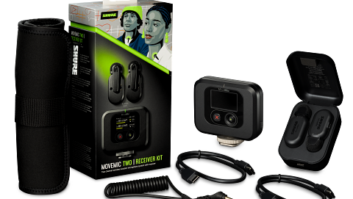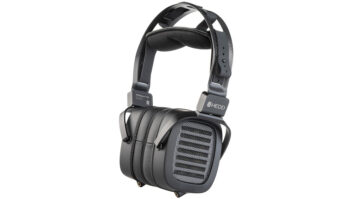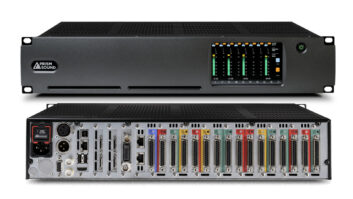For more than a decade, Apogee Electronics has been a pioneer in digital audio technology, releasing numerous products such as state-of-the-art digital filters, format converters and, more recently, conversion systems. The recently introduced PSX-100 functions as a complete 2-channel high-density conversion system and capitalizes on the industry’s migration toward a 24-bit/96kHz audio standard. Housed in a 1U rackmountable enclosure, the unit provides stereo 24-bit/96kHz analog to digital conversion, plus stereo 24-bit digital to analog conversion. The PSX-100 also functions as a bit-splitter and format converter. Incorporating Apogee’s proprietary UV22 word length reduction technology, the PSX-100 outputs 16- and 20-bit word data without any appreciable loss of detail.
The PSX-100 is a comprehensive system. The A/D and D/A sections can function independently of one another and can be clocked separately or cross-connected. Built into the unit are all the industry-standard interfaces, including multiple AES/EBU, S/PDIF (both coaxial and optical), Tascam TDIF and Alesis Lightpipe. The PSX-100 supports high-density sample rates (88.2 and 96 kHz) and the more conventional 44.1 and 48kHz sample rates. One particularly useful feature is an Aux AES/EBU output that always outputs 24-bit full-resolution audio, regardless of what else may be taking place. This feature is very convenient because you can mix to a 24-bit device while taking advantage of the UV22 technology to reduce the bit count for a simultaneous mix to a conventional 16-bit DAT recorder.
In terms of its functions and internal operating modes, the PSX-100 does some very cool stuff. In case you were wondering what on earth you might use to cap-ture a 24-bit/96kHz stereo mix, Apogee Bit-Splitting (ABS) technology enables you to use a conventional MDM recorder. If, for example, you are mixing a 24-bit, 44.1kHz recording to your ADAT or DA-88, the ABS technology uses four tracks to accomplish this. The PSX-100 effectively prints the left channel’s first 16 bits to track 1 while placing the remaining eight least significant bits (LSB) onto track 2. The right channel is handled similarly by using tracks 3 and 4. For a 24-bit/96kHz recording, Apogee’s ABS-96 technology divides the data down the middle again and, hence, uses tracks 1-4 for the left channel and tracks 5-8 for the right channel.
Other noteworthy features include a Soft Limit function that provides maximum digital level to a recording without incurring overruns, the metering of either the A/D output or the D/A input, a Digital Copy Mode to facilitate conversions between the various supported formats, and an Analog Monitor Mode for monitoring the A/D output through the D/A converter. Additionally, an optional video card can provide sync to PAL, NTSC or black-and-white video signals.
The PSX-100’s faceplate is well- organized, making it easy to navigate the various system parameters. A single multiple-press button enables you to select A/D sync options such as the unit’s internal crystal with a sampling rate of 44.1/88.2 kHz or 48/96 kHz-along with options for an external clock source and lock status. Other similar keys allow you to select output resolutions (24-bit, UV22 20-bit, UV22 16-bit) and to define the state of the TOS link port-either S/PDIF or ADAT optical. A small flathead screwdriver is all you need to calibrate both the D/A and A/D converters through the convenient recessed access holes in the front panel. The factory default for the D/A converter is set so that an incoming digital signal at -16dBFS produces a level of +4dBU at the analog outputs.
IN SESSIONAt this point in time, most engineers will probably use the PSX-100 to create a 24-bit high-density mix from an analog source. I say this because, presently, there aren’t that many options (a series of interconnected Genex recorders aside) for actually capturing a multitrack recording in 24-bit/96kHz mode. Let’s face it, Studer 827s (yes, this is an analog machine), Sony 3348s, ADATs and DA-88s are still pretty darn popular. Even Otari’s RADAR II delivers 24-bit audio at the conventional sampling rates of 44.1 and 48 kHz. Although this is likely to change fairly soon, these systems aren’t going away in a hurry. Bottom line-most of us still capture tracks at a level not quite up to par with the PSX-100’s capabilities.
With that said, I opted to feed the PSX-100 an analog stereo mix via the XLR-balanced outputs of a console and print my 24-bit/96kHz mix to eight tracks of a DA-88. After running a pair of XLR cables from the board to the PSX-100 and connecting Tascam’s PW-88D dubbing cable to both the PSX-100’s TDIF Out and the DA-88, I was ready.
Because I was feeding an analog signal, I defined the 48/96kHz setting and internal clock, followed by an output resolution of 24 bits. At this point, I found that I wasn’t feeding signal to all eight tracks of the DA-88 as I expected. Alas, one button-push remained! By pressing and holding the “x2FS” key (which places the unit into Fast mode for high sample rates), signal appeared on all eight tracks of the DA-88, and I was in business.
I printed the mix several times-some with Soft Limit enabled, other times without. While all the mixes recorded without a hitch, I preferred the ones that were created with Soft Limit enabled as I achieved a slightly hotter, more consistent level throughout the recordings. So how did it sound? Not so fast-I’m getting there.
MONITORING WITH CONFIDENCEFor this type of application, the PSX-100 provides two monitoring options: Confidence Monitor Mode and Analog Monitor Mode. In Confidence Mode, the unit’s A/D and D/A converters act independently of one another. You can monitor “off tape” by listening to the returning signal via the PSX-100’s D/A. Conversely, Analog Mode routes the A/D input signals to all digital outputs in addition to the D/A output. In this case, you end up monitoring the output directly from the A/D. While performing your mix, you can easily switch between the two modes simply by pressing and holding the unit’s D/A Input button. In Analog Mode, the A/D Out LED illuminates, but in confidence mode, it does not.
COPY MACHINENow that I had a 24-bit/96kHz high- density stereo mix (which, by the way, could only be heard by replaying the DA-88 through the PSX-100 so that the data could be “re-assembled”), I decided to make a copy of the mix to a conventional 16-bit DAT recorder. This process was slightly trickier than the previous operation because the PSX-100 ships with all its rear panel dip switches in the Down (Off) position and, when using TDIF, dip switch No. 1 must be in the On (Up) LR Clock position.
Kudos to Apogee for creating an owner’s manual that is clear, concise and to the point. With little effort, I was able to determine the error of my ways and rectify the situation. After feeding Word Clock from the DA-88, the PSX-100 seemed much happier. At this point, I selected UV22 16-bit as my output resolution and fed the coaxial signal to the DAT’s coaxial digital input. I was now able to play the DA-88’s high-density mix and convert it to a DAT format that could be played on any conventional DAT machine.
A TOUGH CALLHearing the difference between a 16-bit and a 24-bit recording is much easier than hearing the difference between a 24-bit/48kHz mix and one that was recorded at 24-bit/96kHz. Could I hear a difference between the high-density mix on the DA-88 as opposed to a standard 16-bit mix to a DAT machine? Absolutely. Here, there was no question that the 24-bit recording was more vibrant and revealed greater dynamic contrast than was exhibited by the 16-bit DAT machine. Would I be able to hear the difference between 24-bit/48kHz and the same recording at 24-bit/96kHz? That’s a much tougher call.
Suffice it to say that the Apogee PSX-100 is a very, very good sounding conversion system that is easy to use, is well-documented and is built like a tank. It was pretty damn exciting to be able to create a 24-bit/96kHz mix with so few technical headaches-not once did the unit ever misbehave. At $2,995, the Apogee PSX-100 is an exceptional tool for the high-end facility in search of a convenient means of delivering high-resolution, high-density master recordings.
Apogee Electronics, 3145 Donald Douglas Loop South, Santa Monica, CA 90405; 310/915-1000; fax 310/391-6262; www.apogeedigital.com.


